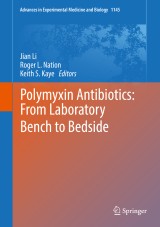Details

Polymyxin Antibiotics: From Laboratory Bench to Bedside
Advances in Experimental Medicine and Biology, Band 1145
|
CHF 212.50 |
|
| Verlag: | Springer |
| Format: | |
| Veröffentl.: | 30.07.2019 |
| ISBN/EAN: | 9783030163730 |
| Sprache: | englisch |
Dieses eBook enthält ein Wasserzeichen.
Beschreibungen
<p>This volume is the first-ever complete treatise on polymyxins and presents the most comprehensive and up-to-date reviews of all major research and clinical topics from chemistry, microbiology, pharmacology, clinical use, to drug discovery. All chapters were written by internationally leading researchers and clinicians in the field.</p><p>It is our wish that readers discover the importance of polymyxin structure in relation to the mechanisms of activity, resistance and toxicity. We emphasized that reliable analytic methods for polymyxins are critical when investigating their pharmacokinetics (PK) and pharmacodynamics (PD). The complicated dose definitions and different pharmacopoeial standards have already compromised the safe use of polymyxins in patients. Therefore, informed by the latest pharmacological information, scientifically-based dosing recommendations have been proposed for intravenous polymyxins. Considering the PK/PD limitations and potential development of resistance, polymyxin combinations are encouraged; however, the current literature has not shown definite microbiological benefits, possibly because most clinical studies to date overlooked key PK/PD principles. Nephrotoxicity is the major dose-limiting factor and it is imperative to elucidate the mechanisms and develop novel approaches to minimize polymyxin-associated toxicities. In addition, the anti-endotoxin effect of polymyxins supports their clinical use to treat Gram-negative sepsis. Fortunately, the discovery of new-generation polymyxins with wider therapeutic windows has benefited from the latest achievements in polymyxin research.</p><p></p>
<p>This book provides extensive pharmacological information on polymyxins to infectious diseases clinicians, pharmacists, clinical microbiologists, antimicrobial pharmacologists, and pharmaceutical scientists, and is an essential read for those who aim to develop novel polymyxins and improve their clinical use as a last-line defense against Gram-negative ‘superbugs’. </p>
<p>This book provides extensive pharmacological information on polymyxins to infectious diseases clinicians, pharmacists, clinical microbiologists, antimicrobial pharmacologists, and pharmaceutical scientists, and is an essential read for those who aim to develop novel polymyxins and improve their clinical use as a last-line defense against Gram-negative ‘superbugs’. </p>
Overview.- Multidrug resistant Gram-negative pathogens: the urgent need for ‘old’ polymyxins.- Discovery, antibacterial spectrum and chemistry.- Mechanisms of antibacterial activity.- Mechanisms of resistance.- Bioanalysis and stability of polymyxins.- In vitro pharmacodynamics and PK/PD in animals.- Antibacterial susceptibility breakpoints.- Labeling of parenteral products of colistin methanesulfonate.- Meta-analysis of polymyxin use in patients.- Clinical use of colistin.- Clinical use of polymyxin B.- Pharmacokinetics, pharmacodynamics, toxicodynamics and dosing recommendations.- Rational combinations with other antibiotics.- Toxicities in patients: management and mechanisms.- Antiendotoxin effect.- Discovery of novel polymyxin-like antibiotics.- Conclusion.
<p>This volume is the first-ever complete treatise on polymyxins and presents the most comprehensive and up-to-date reviews of all major research and clinical topics from chemistry, microbiology, pharmacology, clinical use, to drug discovery. All chapters were written by internationally leading researchers and clinicians in the field.</p><p>It is our wish that readers discover the importance of polymyxin structure in relation to the mechanisms of activity, resistance and toxicity. We emphasized that reliable analytic methods for polymyxins are critical when investigating their pharmacokinetics (PK) and pharmacodynamics (PD). The complicated dose definitions and different pharmacopoeial standards have already compromised the safe use of polymyxins in patients. Therefore, informed by the latest pharmacological information, scientifically-based dosing recommendations have been proposed for intravenous polymyxins. Considering the PK/PD limitations and potential development of resistance, polymyxin combinations are encouraged; however, the current literature has not shown definite microbiological benefits, possibly because most clinical studies to date overlooked key PK/PD principles. Nephrotoxicity is the major dose-limiting factor and it is imperative to elucidate the mechanisms and develop novel approaches to minimize polymyxin-associated toxicities. In addition, the anti-endotoxin effect of polymyxins supports their clinical use to treat Gram-negative sepsis. Fortunately, the discovery of new-generation polymyxins with wider therapeutic windows has benefited from the latest achievements in polymyxin research.</p><p>This book provides extensive pharmacological information on polymyxins to infectious diseases clinicians, pharmacists, clinical microbiologists, antimicrobial pharmacologists, and pharmaceutical scientists, and is an essential read for those who aim to develop novel polymyxins and improve their clinical use as a last-line defense against Gram-negative ‘superbugs’.</p>
Provides a comprehensive review on pharmacokinetics, pharmacodynamics and toxicity of polymyxins Clarifies the confusing definitions of potency of colistin used in different parts of the world Reviews strategies of discovery of novel polymyxin-like antibiotics
Diese Produkte könnten Sie auch interessieren:

Tropical and Parasitic Infections in the Intensive Care Unit
von: Charles Feldman, George A. Sarosi
Preis: CHF 177.00
-
-
© 2024 media control GmbH
Alle Preise enthalten die gesetzliche Mehrwertsteuer. - AGB
- Impressum
- Datenschutzerklärung
- Kontakt
- FAQ
- Mein Konto
- Home
- Erweiterte Suche
- Widerrufsrecht
- Reader-Software
- Desktop-Ansicht
- Gutschein-Code einlösen

